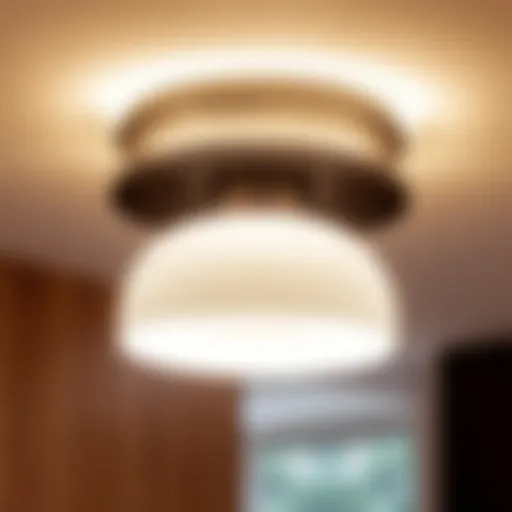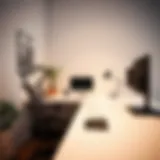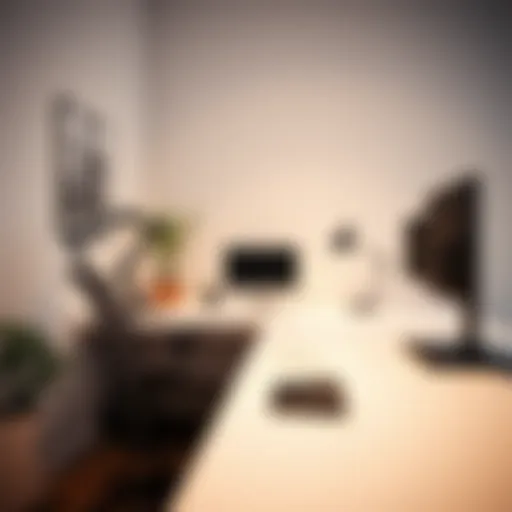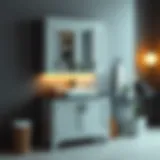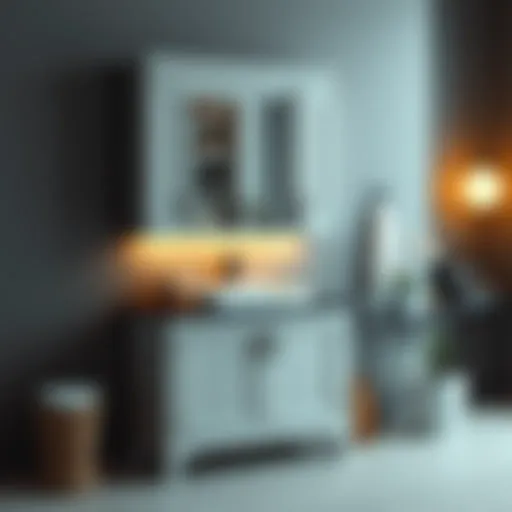Exploring the Benefits of Folding Sewing Cabinets
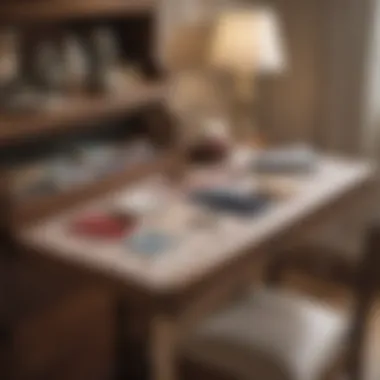

Intro
Folding sewing cabinets represent a blend of practicality and elegance within the sewing community. For homeowners, renters, designers, and DIY enthusiasts alike, these cabinets provide not only a workspace but also an often-overlooked piece of furniture that contributes to home aesthetics. With the surge in interest towards home crafting and activities that foster creativity, folding sewing cabinets have gained popularity for their versatility and functionality.
As spaces in urban living continue to shrink, the significance of furniture that can be compacted when not in use cannot be overstated. These cabinets have evolved from rudimentary designs to intricate, customizable solutions that seamlessly fit into modern décor. Understanding their dynamics—from market trends to styles—can provide readers with the insights they need to choose their ideal cabinet, ensuring that it harmonizes with their creative endeavors and living space.
Through this article, we will unravel the reasons behind the increasing appeal of folding sewing cabinets and how they can elevate any craft space. From design and style explorations to practical DIY projects that can be considered, we aim to equip you with all the necessary know-how to conduct your sewing practices efficiently while enhancing the beauty of your home.
Understanding the Folding Sewing Cabinet
Folding sewing cabinets are more than just functional furniture; they symbolize a fusion of creativity and practicality, catering to sewing enthusiasts, busy homeowners, and interior designers alike. Understanding these cabinets involves diving into their design, purpose, and the sheer variety they offer for all kinds of spaces. This is important as it showcases how such a piece can redefine a sewing workspace, providing both organization and aesthetic appeal.
Historical Context
The journey of folding sewing cabinets dates back to the artistry of craftspeople who sought to enhance their sewing experience. Initially, sewing tools were stored haphazardly—needles, threads, and textiles piled together. As the sewing arts evolved, so too did the need for organization.
Craftsmen started designing cabinets that not only accommodated sewing equipment but also evolved with the development of sewing machines. The folding aspect came into play to address limited space in many homes. In the mid-19th century, as sewing gained popularity, the folding sewing cabinet became a staple in many households. No longer just functionality, these cabinets offered a visual charm that mirrored the elegant furniture of the time. In essence, they evolved from basic storage solutions to multi-faceted pieces showcasing craftsmanship and practicality.
Purpose and Utility
The purpose of a folding sewing cabinet transcends simple storage; it's about creating a dedicated space for creativity that can quickly be tucked away when not in use. Here are some key aspects:
- Space Efficiency: For those living in apartments or smaller homes, the folding feature allows one to maximize their available space. A cabinet can be easily opened for use and stored away when sewing is complete.
- Organization: It addresses the clutter that often frustrates sewing enthusiasts. With designated compartments, everything from scissors to fabric is systematically arranged, making it easier to locate essentials in the heat of the moment.
- Design Versatility: Many folding sewing cabinets are crafted with aesthetics in mind, fitting seamlessly into various designs—from rustic farmhouse to contemporary chic. This not only enhances decoration but also propels the notion that sewing is an art.
- Adaptability: The modern crafting spaces require flexibility. A folding sewing cabinet can be adapted for various uses—be it sewing, crafting, or even a makeshift workstation for kids’ projects.
Folding sewing cabinets stand at the intersection of form and function, revolutionizing how we view sewing in the home.
In summary, understanding the folding sewing cabinet involves recognizing its rich history, practical benefits, and its role in optimizing sewing spaces. Whether you are a seasoned sewer or new to the craft, the folding sewing cabinet presents itself as an essential addition that caters to both utility and style.
Design Features of Folding Sewing Cabinets
Design elements sketched into folding sewing cabinets are more than just about looks; they play a central role in how these pieces serve sewing enthusiasts. As anyone with a penchant for crafting knows, the right workspace can spark creativity. So, when you think of folding sewing cabinets, you gotta think about how structural features combine with aesthetics to meet practical needs. Let’s dive deeper into these aspects.
Structural Elements
When it comes to structural aspects of folding sewing cabinets, one can easily point to their clever engineering. These cabinets are designed with versatility in mind, offering a seamless blend of sturdiness and functionality.
- Material Choices: You often find cabinets made from a variety of materials, including wood, metal, or composite boards. Each material offers its own flavor of durability and weight. For instance, solid wood cabinets typically bring an old-world charm but can be heavier than their composite counterparts.
- Foldable Mechanisms: The way these cabinets fold is a feat of design. Some employ hinge systems, while others might use sliding panels. A well-constructed foldable mechanism allows for easy opening and closing without sacrificing stability while in use.
- Storage Solutions: Look closely, and you'll see multi-tiered shelves and compartments tucked away intelligently. Drawers, pull-out trays, and sometimes even baskets ensure your sewing supplies have a home. A thoughtful arrangement stays out of the way when the cabinet is closed but accessible when you’re ready to sew, making organization breezy.
"A poorly designed cabinet can become a hindrance, but a well-constructed one empowers creativity, making the sewing experience enjoyable."
Aesthetic Considerations
Thinking about the aesthetics of folding sewing cabinets isn’t solely an afterthought. The visual appeal of these cabinets can enhance a room and create a welcoming atmosphere in any crafting space.
- Finish and Color Options: Wood finishes can range from natural varnishes that highlight grain patterns to colored paints that align with modern decor. A light oak finish might breathe freshness into a traditionally styled room, while a bold navy blue could accentuate a sleek, contemporary area.
- Design Styles: The variety in design is striking, with cabinets catering to both vintage tastes—think ornate carvings or distressed wood—and sleek modern minimalist vibes characterized by clean lines and understated elegance.
- Integration into Home Decor: A folding sewing cabinet can sometimes double as a decorative piece. A well-placed cabinet in a living room or guest room not only serves a purpose but also adds character to the home. Some can even be elegantly disguised as other furniture pieces, like desks, blurring functionality with style.
Types of Folding Sewing Cabinets
In exploring the realm of folding sewing cabinets, understanding the different types is crucial for any sewing enthusiast or homeowner. Each type offers distinct features and benefits that cater to varying needs, from space limitations to aesthetic preferences. These cabinets not only serve as functional workspaces but also enhance the overall decor of your home. Thus, grasping the characteristics of each type can significantly influence your decision-making process.
Traditional vs. Modern Designs
When it comes to folding sewing cabinets, choosing between traditional and modern designs hinges on personal taste and the existing interior layout.
Traditional designs tend to embody classic craftsmanship and timeless finishes. These cabinets often feature rich woods, intricate carvings, and vintage hinges. They invoke a sense of nostalgia, which can be quite appealing for those who appreciate history and craftsmanship. For instance, an oak sewing cabinet from the mid-century might display a level of detail and durability that simply can’t be replicated today.
On the other hand, modern designs embrace simplicity and functionality. They prioritize clean lines and minimalistic elements, often constructed from materials such as laminate or metal. These cabinets provide a sleek, contemporary look that tends to blend seamlessly with current home decor trends. The IKEA Sy particle board cabinet is a fine example, integrating utility with a fresh aesthetic that attracts many design-conscious DIYers.
The choice ultimately impacts not just functionality but also how well the cabinet complements your living space. For a cozy home office with vintage accents, traditional might just fit the bill. In contrast, a bustling apartment might shine with a simple, space-saving modern design.
Compact and Multi-Functional Models
Compact and multi-functional folding sewing cabinets have gained substantial popularity, particularly among city dwellers and those with limited space. These models provide the ultimate solution for maximizing utility without sacrificing style. A compact cabinet, often resembling a narrow side table when closed, can be transformed into a full-fledged sewing station with a quick flick of the wrist.
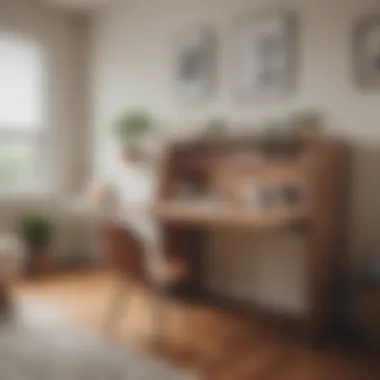

Multi-functional models go a step further, often incorporating features such as built-in storage for notions, threads, and fabric. Sometimes, these cabinets even include additional surfaces that can serve double-duty as a workspace for other crafts or hobbies. The Sew Ready – Portable Sewing Table comes to mind, easily transitioning from a tidy storage unit to a vibrant, fully equipped sewing space.
Embracing compact and multifunctional options means being smart with your space. For instance, investing in a cabinet that doubles as a decor piece can significantly reduce clutter and enhance your home's functionality. As the space-saving trend continues to infiltrate home design, having a versatile sewing cabinet becomes more of a necessity than just an option for many. By selecting the right compact model, you not only meet your sewing needs but also contribute to a tidy, organized environment.
Choosing the right type of folding sewing cabinet can transform both your sewing experience and your living space.
Selecting the Right Folding Sewing Cabinet
When diving into the world of sewing, choosing the right folding sewing cabinet can feel like navigating through a maze. With options galore, this decision is less about just aesthetics and more about tailoring your workspace to fit your unique needs. Getting it right not only enhances your sewing experience but also keeps your creative zone organized and inspiring. Here's why it's essential to take a thoughtful approach to this choice.
Assessing Space Requirements
Before you even think about style and fabric storage, consider your available space. Are you blessed with a large sewing nook, or are you limited to a compact corner? Folding sewing cabinets are inherently versatile, designed to collapse into a smaller footprint when not in use. However, knowing your space constraints helps you avoid the "it looked great on the showroom floor" trap.
- Measure Twice, Cut Once: Take out that tape measure and jot down the dimensions of your available space. Think not just about the cabinet but also about how much room you'll need to comfortably sew, maneuver fabric, and store tools.
- Consider Accessibility: A sewing cabinet is only as good as its accessibility. Make sure your chosen model allows easy access to the essential tools without cramping your style. Sometimes, too much folding and stacking can lead to cumbersome workflows.
- Visualize the Set-up: Before jumping in, try to visualize where the cabinet will sit. How will the light hit your workspace? Will it work harmoniously with other furniture or décor already present?
Material Durability and Finishes
Durability plays a crucial role in the longevity of your investment. When selecting a folding sewing cabinet, think not just about how it looks but how it will fare through years of projects. Consider these aspects:
- Material Choices: Strong, resilient materials like plywood or solid wood can take the wear and tear of a busy crafting area. Cheap particle board might seem budget-friendly, but it’s often not worth the hassle when it starts to warp or chip.
- Finish Matters: The finish isn’t just a cosmetic element; it also protects the cabinet. A good lacquered or varnished surface makes it easier to clean and resists scratches, which is a godsend when dealing with fabric and threads.
- Weight Capacity: If you envision a heavy machine sitting atop the cabinet, ensure it can support that weight without wobbling or breaking a sweat. Look at user reviews discussing stability for peace of mind.
Budget-Friendly Options
Budget constraints can make it daunting to choose the right folding sewing cabinet, but don’t despair. Quality options exist at various price points. Here are some ways to maximize your budget:
- Explore Pre-Owned Market: Sometimes, second-hand cabinets can be gems in disguise. Platforms like Craigslist or local thrift shops can yield high-quality items at a fraction of the new price. Just check for signs of damage, and you've struck gold.
- Set Your Priorities: Identify what’s absolutely essential for your sewing adventures. If you're not a frequent traveler with your supplies, you might be better off skipping a cabinet that specializes in portability for a more robust workstation.
- Utilize Sales and Discounts: Don’t hesitate to hunt for sales, especially during major home goods events or holidays. Many retailers offer discounts on sewing furniture, and you might find the perfect cabinet at a price you can manage.
Folding sewing cabinets are not merely functional pieces; they are integral parts of a sewing passion that deserve careful thought. Balancing your needs with aesthetics, space, materials, and budget can lead you to the cabinet that feels just right, both for your sewing projects and your unique living space.
"The right tool in the right place improves not only your work but also your joy in creating."
Embrace the exciting journey of selecting your sewing cabinet thoughtfully, and it can elevate both your craft and your creativity at home.
Customization Possibilities
When it comes to folding sewing cabinets, customization isn't just a buzzword—it's a pivotal aspect that transforms a generic piece of furniture into a tailored haven for creativity. The beauty of custom options lies in their ability to cater to personal preferences, functional needs, and aesthetic desires. A well-customized cabinet can turn a cluttered workspace into a well-organized sanctuary, enabling users to focus on their sewing designs rather than the mess around them. Moreover, customization can lead to an increase in satisfaction with the workspace, which subsequently enhances productivity.
Personalizing Design Elements
Personalizing the design elements of a folding sewing cabinet can mean stepping from the ordinary to the extraordinary. Many manufacturers offer a palette ranging from classic neutrals to bold colors that match your interior decor. For example, if you're leaning toward a shabby chic style, you might opt for pastel colors, whereas a sleek modern home might call for something in black or white.
Beyond colors, materials are also crucial. There’s a myriad of finishes available: you might prefer a warm walnut wood or a glossy laminate. The texture can either invite warmth or a modern sleekness. For instance, if you’re a sewist who enjoys the feel of natural materials, a solid wood cabinet could be a great choice.
Don’t overlook hardware either—knobs, handles, and hinges can also be personalized. It’s these details that can make your cabinet uniquely yours.
Incorporating accessories like a built-in ironing board or a dedicated compartment for your fabric rolls can add layers of functionality. Consider the following options:
- Adjustable shelves to adapt as your needs change
- Customizable drawer layouts to accommodate various supplies
- Different leg styles to achieve the desired height for comfort
"A sewing cabinet should not just house your tools—it should inspire you to create."
Incorporating Additional Storage Solutions
Storage solutions are critical in the realm of sewing, where tools, fabrics, and accessories often clutter your space. A folding sewing cabinet’s design can significantly impact your organization's capabilities. Opting for additional storage solutions transforms a basic cabinet into a multifunctional piece.
You'll want to consider the following additions:
- Vertical Compartments: Perfect for thread spools or scissors, helping you keep everything within arm’s reach without digging through drawers.
- Rolling Carts: If you lack space, a small, rolling cart can be an add-on that can be tucked under or beside your cabinet, offering mobile storage.
- Drawer Dividers: These can help you sort needles, buttons, and other small items systematically.
- Pegboards or Wall-mounted Systems: If you're really tight on space, utilizing vertical space can free up room in your sewing cabinet and keep frequently used items visible for quick access.
By thoughtfully integrating these additional solutions, your folding sewing cabinet becomes not just a sewing station but a well-structured ecosystem that fosters not only creativity but efficiency as well. Take these customization possibilities and make your sewing cabinet truly yours.
Maintenance and Care
When investing in a folding sewing cabinet, the excitement may overshadow the need for ongoing care and maintenance. However, keeping your cabinet in top shape is crucial to ensure its longevity, functionality, and aesthetics. Over time, dust can gather and everyday wear and tear can have an impact. Not addressing these issues might lead to inconveniences when using the cabinet, and nobody wants that when they’re deeply engaged in their sewing projects.
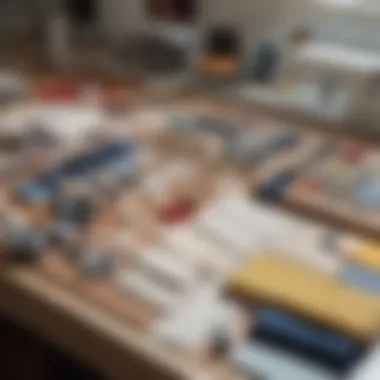

Cleaning Techniques
A clean environment fosters creativity. Regularly cleaning your folding sewing cabinet not only enhances its appearance but also contributes to a better sewing experience. Here are a few basic yet effective cleaning techniques:
- Dusting: Use a soft, dry cloth to wipe down surfaces. Don’t forget hard-to-reach areas; dust can settle into joints and hinges.
- Vacuuming: For intricate designs or grooves, a vacuum with a nozzle attachment can help clear out stubborn dust.
- 使用的适当清洁剂: Depending on the finish, a mild soap solution can be used for deeper cleaning. Always test on a small area first to prevent damage.
- Polishing: Using a compatible furniture polish can provide a shine and lay a protective layer against scratches or spills.
Adopt the mantra: "A stitch in time saves nine." If you stay on top of the cleaning, it’s less likely you’ll face significant issues down the line.
Repairing Common Issues
Despite the best of care, wear and tear can occur. Being proactive in repairing small issues can save you time and money.
- Loose Hinges: Over time, hinges might become loose. Using a screwdriver, check and tighten them regularly to prevent any complete breakage.
- Surface Scratches: For minor scratches on the finish, a touch-up pen in a matching color can often do the trick. If the scratch is deeper, consider sanding it carefully before applying a new finish.
- Drawer Problems: If drawers begin to stick, it could be due to dirt accumulation or misalignment. Clean the slider tracks and, if necessary, readjust the alignment.
"An ounce of prevention is worth a pound of cure" is an old saying, but it rings especially true. Regular checks and fixes can turn potential disasters into minor repairs.
By implementing regular maintenance and addressing issues early, your folding sewing cabinet can remain a powerful ally in your crafting journey. Your creativity deserves a space that inspires, and that starts with keeping it clean and functional.
Storage Solutions and Organization Tips
In the world of crafting and sewing, having a well-organized workspace can make all the difference. Folding sewing cabinets are not just about aesthetics; they offer practical solutions for storage, helping you keep your supplies in order. When your tools and materials are easy to find, creativity flows naturally. Let’s explore how to organize your sewing supplies effectively and make the most of limited space.
Organizing Sewing Supplies Effectively
To store sewing supplies like a pro, think of your cabinet as a small universe tailored for your projects. Grouping similar items together can save time and frustration. Here are some strategies to consider:
- Use Clear Bins: Transparent storage bins allow you to see at a glance what you have. This is especially useful for smaller items like buttons, threads, or sewing needles.
- Label Everything: If you’re losing track of where things go, slapping on some labels can be a game changer. Make it easy to find what you need without rummaging through piles.
- Keep Frequently Used Items Accessible: Place the items you use most often—like scissors, measuring tape, and your favorite fabrics—closer to the top or front of the cabinet. The less you have to dig, the more time you can spend sewing.
- Utilize Vertical Space: Don’t overlook the height of your cabinet. Store taller items upright in designated spaces to prevent them from getting lost or damaged.
"A well-organized space is a canvas for creativity. When everything has a place, you're free to experiment and innovate."
This approach not only enhances efficiency but also promotes a sense of calm in your sewing environment.
Maximizing Small Spaces
Living in a cozy apartment or a small house doesn’t mean you need to give up on your passion for sewing. Folding sewing cabinets can make the most of your limited space. Here are a few ideas:
- Choose Multi-Functional Furniture: Some cabinets can double as a side table or desk when not in use, providing a stylish and functional solution to space constraints.
- Foldable Designs: Select a cabinet that can be easily folded away when not in use. This way, you can reclaim your space and keep your home looking tidy.
- Incorporate Overhead Storage: If floor space is a premium, think about utilizing vertical wall space or shelves above your cabinet. Storing items above you keeps the floor clear and can add flair to any room.
- Opt for Slim Models: Searching for a cabinet that offers a slim silhouette can help blend into tight corners or nooks without taking up too much area.
When you arrange your sewing cabinet wisely, even the tiniest nooks can transform into efficient workspaces, allowing you to unleash your creative spirit without cluttering your home.
Folding Sewing Cabinets in Different Interiors
The role of folding sewing cabinets in various interiors cannot be overlooked. Not only do these cabinets serve the practical needs of sewing enthusiasts, but they also form an integral part of the home’s overall aesthetic. A well-placed folding sewing cabinet can be the difference between a cluttered workspace and a harmonious living environment. Understanding how these cabinets fit into different decor styles can vastly enhance both functionality and visual appeal.
Integrating with Modern Decor Styles
Modern home design tends to favor clean lines and minimalism. Folding sewing cabinets designed with sleek profiles and neutral color palettes can blend seamlessly into contemporary settings. Think about a cabinet finished in matte white or a muted gray, which complements other modern furnishings.
Incorporating such cabinets involves thoughtful placement. For instance:
- Place the cabinet in a well-lit corner of the room to not only make it the sewing hub but also maintain an airy feel.
- Consider open shelving integrated into the cabinet design to display vibrant fabrics. Not only does this serve a practical purpose, but it also adds a pop of color to the decor.
- Select cabinets that feature a fold-down work surface, allowing for easy transformation from a sewing space to a lovely accent piece.
These choices can elevate the overall look of your modern home while ensuring that your hobby doesn’t compromise style.
Compatibility with Vintage Aesthetics
On the flip side, vintage aesthetics hold a charm that’s hard to match. A folding sewing cabinet can integrate beautifully into a home that celebrates nostalgia. When looking for a cabinet that resonates with vintage style, you might want to consider:
- Ornate details: Cabinets that feature intricate carvings or wrought iron handles can add character.
- Warm woods: Opting for a piece made from mahogany or walnut can evoke warmth and history. The grain of the wood often tells a story of its own.
- Colorful finishes: Using painted cabinets in pastel shades or even distressed finishes can enhance a vintage vibe.
Positioning these cabinets thoughtfully is key. A vintage sewing cabinet can be nestled against wallpaper with floral patterns or in a sun-drenched nook filled with eclectic trinkets. This setup not only reflects individual taste but also creates inviting, memorable spaces.
"The sweetest joy, the wildest woe, is love." After all, creating an environment you love will foster a more enjoyable sewing experience.
By considering both modern and vintage decor styles, homeowners can select folding sewing cabinets that not only meet their practical needs but also enhance the beauty and functionality of their living spaces.
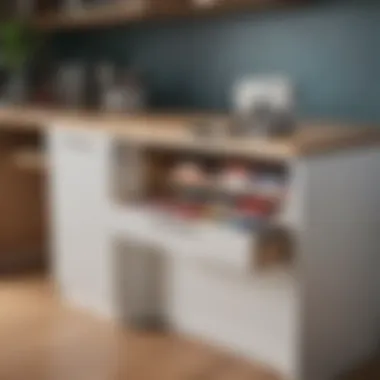

Popular Brands and Models
When discussing folding sewing cabinets, one cannot overlook the significance of popular brands and models in shaping the sewing landscape. These cabinets do more than simply serve as storage; they represent a symbol of craftsmanship and innovation. Homeowners and enthusiasts alike tend to gravitate toward brands that not only showcase durability but also accentuate aesthetic design principles. The selection of a well-regarded brand can suggest a commitment to quality and a level of trustworthiness that can make all the difference in user experience.
Renowned Manufacturers
Some manufacturers have etched their names in the annals of sewing furniture. Companies like Sauder, known for their innovative space-saving designs, focus heavily on making the most out of compact areas. Their folding sewing cabinets often come with extra features like adjustable shelves and hideaway compartments, which make them particularly attractive to DIYers with limited room.
Then there's Kathy Ireland, who mixes practical utility with floral aesthetics, appealing to those who value both function and style. The aesthetic appeal of their cabinets blends seamlessly into home interiors without making it feel like a workspace. Beyond iconic style, these cabinets offer ample storage and are often equipped with a smooth workspace for detailed sewing tasks.
Other noteworthy names include Horn of America and Sewing Machine Shop, who cater exclusively to sewing enthusiasts. Their offerings often represent the peak of high-quality craftsmanship, featuring robust construction that withstands years of wear.
User Reviews and Recommendations
In a world where an informed choice can save one from buyer's remorse, user reviews are the gold standard for gauging the reputability of folding sewing cabinets. Happy customers often praise their cabinets for ease of assembly and functionality.
"I bought a folding sewing cabinet from Sauder, and it fits perfectly in my tiny apartment. It was easy to put together, and now I can keep my sewing projects organized and within reach!"
On forums and sites like Reddit, you can find countless discussions about folding cabinets, where users share detailed insights. Key considerations often discussed include:
- Stable Work Surface: Many users recommend cabinets that enhance stability during sewing sessions, which is crucial for accuracy.
- Storage Space: Plenty of compartments are a common request since a disarray of supplies can lead to frustration.
- Portability: The ability to move a cabinet around is highly appreciated, especially in multipurpose rooms.
- Customer Services: Prompt and effective customer service from manufacturers is often highlighted as a crucial factor during the purchasing experience.
Incorporating user feedback into the decision-making process is invaluable. It assists potential buyers in making choices that align with their specific needs, ensuring that the investment in a folding sewing cabinet will enhance their sewing endeavors effectively.
Sustainability Considerations
In today's world, sustainability is more than just a buzzword; it's a movement that affects how we approach all aspects of our lives, including our hobbies and interests. When it comes to folding sewing cabinets, understanding sustainability considerations becomes crucial, especially for sewing enthusiasts who wish to create a positive impact through their choices. There are multiple dimensions to this discussion, such as ethical sourcing of materials, innovative crafting techniques, and the overall lifespan of the products we choose.
Sustainable practices foster not only a healthier environment but also contribute to a more conscientious economy. People are becoming more aware of the impact their purchasing decisions can have. In sewing, opting for cabinets that align with sustainable values can enhance creativity and responsibility concurrently.
Ethical Sourcing and Materials
When we talk about ethical sourcing, we're diving into the nitty-gritty of where and how the materials for these cabinets are obtained. Opting for woods from sustainable forests or reclaimed materials ensures that we are not contributing to deforestation or habitat destruction. Moreover, manufacturers that prioritize ethical sourcing aim to support local communities, which often leads to fair wages and better working conditions for laborers.
Here are some things to consider when selecting a folding sewing cabinet:
- Material Origin: Check if the wood is certified by organizations like the Forest Stewardship Council (FSC).
- Transparency: Look for brands that openly share their sourcing processes and labor practices.
- Environmental Certifications: Seek cabinets that meet green certifications, ensuring a reduced carbon footprint during production and delivery.
Making informed choices about materials can uphold the principles of fairness and responsibility in your crafting journey.
Eco-Friendly Practices in Crafting
Crafting practices can also contribute to sustainability. For instance, if you choose to make or customize your own folding sewing cabinet, using eco-friendly paints, varnishes, and adhesives can minimize releases of volatile organic compounds (VOCs), which can be detrimental to indoor air quality. Scraps from previous projects can sometimes be repurposed in making your cabinet, limiting waste.
Useful eco-friendly crafting strategies:
- Upcycling: Transforming old furniture into a functional sewing cabinet not only uses available resources, but it's also a fun way to showcase personal style.
- Natural finishes: Opt for finishes like beeswax or plant-based oils instead of synthetic alternatives.
- Minimalism: Designing a cabinet that requires fewer materials allows for a sleeker, more efficient product. This approach could also lead to reduced shipping costs, making your overall impact lesser.
By incorporating eco-friendly crafting practices into your sewing cabinet choices, you make a tangible contribution to environmental health, all while enjoying your craft.
Sustainability isn’t just a trend; it’s a responsibility we carry for future generations, and every little choice counts.
The End
In summarizing our exploration of folding sewing cabinets, it becomes evident that these versatile furniture pieces play a crucial role in the sewing world and home decor. Not only do they serve practical purposes, such as providing a designated area for sewing projects, but they also contribute significantly to enhancing the visual appeal of a room. The importance of making an informed choice cannot be overstated, as selecting the right cabinet can elevate both functionality and aesthetic appeal within a space.
When considering the myriad options on the market, it's essential to evaluate the specific needs and preferences one holds. Folding sewing cabinets vary widely in design, from sleek modern options to more ornate traditional workstations. Each style brings with it distinct advantages and drawbacks that should be weighed thoughtfully. Space is another vital consideration; a cabinet that folds neatly away can free up valuable floor space in a small apartment or studio, while larger models provide ample storage for extensive supplies.
The design features also significantly impact usability. Features such as built-in lighting, extendable surfaces, and integrated storage options can dramatically improve the sewing experience. Moreover, maintenance and care of these cabinets must not be overlooked. Protecting the finish, ensuring smooth operation, and resolving any wear and tear quickly can prolong the life of the cabinet and keep it looking its best.
Ultimately, embracing a folding sewing cabinet is not just about acquiring furniture. It’s about creating a conducive environment for creativity and productivity in your sewing endeavors. The right cabinet can turn even the smallest nook into a functional and inspiring workspace.
Recap of Key Takeaways
- Folding sewing cabinets are essential for both practicality and aesthetic appeal in sewing spaces.
- Choosing the right cabinet involves assessing design, space requirements, and personal preferences.
- Maintenance and care extend the life and functionality of these cabinets, ensuring a lasting investment.
- Integrating a sewing cabinet into your home fosters creativity and enhances the overall decor.
Final Thoughts on Adopting a Folding Sewing Cabinet
Adopting a folding sewing cabinet can be a transformative decision for anyone engaged in sewing, whether as a hobby or profession. As emphasized throughout this article, the careful consideration of design features, utility, and personal style can lead to a satisfactory purchase that caters to individual needs.
Investing in such a cabinet not only improves your sewing experience but can also serve as a centerpiece in your workspace. With the right cabinet, you are not just buying furniture; you are making a statement about your love for the craft. So, take your time in selecting the perfect fit and enjoy the creative journey that unfolds.



